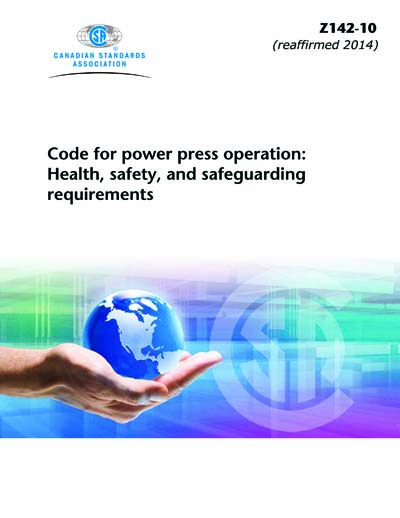Most recent
CSA Z142-10 (R2019)
Code for power press operation: Health, safety, and safeguarding requirements
Preface This is the fifth edition of CSA Z142, Code for power press operation: Health, safety, and safeguarding requirements. It supersedes the previous editions, published in 2002 under the title Code for Power Press Operation: Health, Safety, and Guarding Requirements, 1990, 1976, and 1957 under the title Code for Punch and Brake Press Operation: Health, Safety, and Guarding Requirements. Scope 1.1 This Standard applies to the design, manufacturing, installation, maintenance, and operation of power presses (presses). The purpose of this Standard is to reduce the risk of injury to people working on or adjacent to presses during press set-up, operation, and maintenance. 1.2 This Standard covers the occupational health and safety requirements for all classes of presses, i.e., mechanical (servo, part-revolution clutch, and full-revolution clutch), hydraulic, and pneumatic, that are fitted with a slide/ram/platen (or slide/ram/platens), and with dies for blanking, cutting, trimming, drawing, punching, forming, bending, stamping, assembling, or processing metal or other materials, or for die proving and tryout. Note: The following are examples of equipment commonly referred to as power presses: (a) manually fed presses; (b) automatically fed presses; (c) transfer presses; (d) tandem line presses; (e) servo presses/direct-drive presses; (f) press brakes; (g) powdered-metal presses; (h) presses used within production cells; (i) spotting presses; and (j) presses used in the hydro-forming process. 1.3 The following machines are excluded from this Standard: (a) cold headers and forming machines; (b) horizontal and vertical bulldozers; (c) eyelet machines; (d) forging presses and hammers; (e) high-energy-rate presses; (f) spot and projection welders; (g) injection moulding machines; (h) riveting machines; (i) turret presses; (j) wire termination machines; (k) bearing and bushing insertion machines; (l) leak testers; (m) die-casting machines; (n) printing industry presses and die-cutting machines; (o) extrusion presses; (p) horizontal benders; and (q) ironworking machines. 1.4 This Standard specifies general health and safety requirements for presses and details safety requirements in danger zones in and around the point of operation. 1.5 Machines processing material whose temperature during processing exceeds 760 C (1400 F) are associated with the metal-forging industry and are outside of the scope of this Standard. 1.6 A press is typically not a stand-alone device, but is integrated into an automated work cell with other machinery or devices that have Standards covering their use. Accordingly, users of this Standard should review the requirements of other applicable Standards as a part of implementing the requirements of this Standard. 1.7 The values given in SI (metric) units are the standard. The values in parentheses are for information only. 1.8 In CSA Standards, "shall" is used to express a requirement, i.e., a provision that the user is obliged to satisfy in order to comply with the standard; "should" is used to express a recommendation or that which is advised but not required; "may" is used to express an option or that which is permissible within the limits of the standard; and "can" is used to express possibility or capability. Notes accompanying clauses do not include requirements or alternative requirements; the purpose of a note accompanying a clause is to separate from the text explanatory or informative material. Notes to tables and figures are considered part of the table or figure and may be written as requirements. Annexes are designated normative (mandatory) or informative (non-mandatory) to define their application.
Content Provider
CSA America, Inc. [csa]






